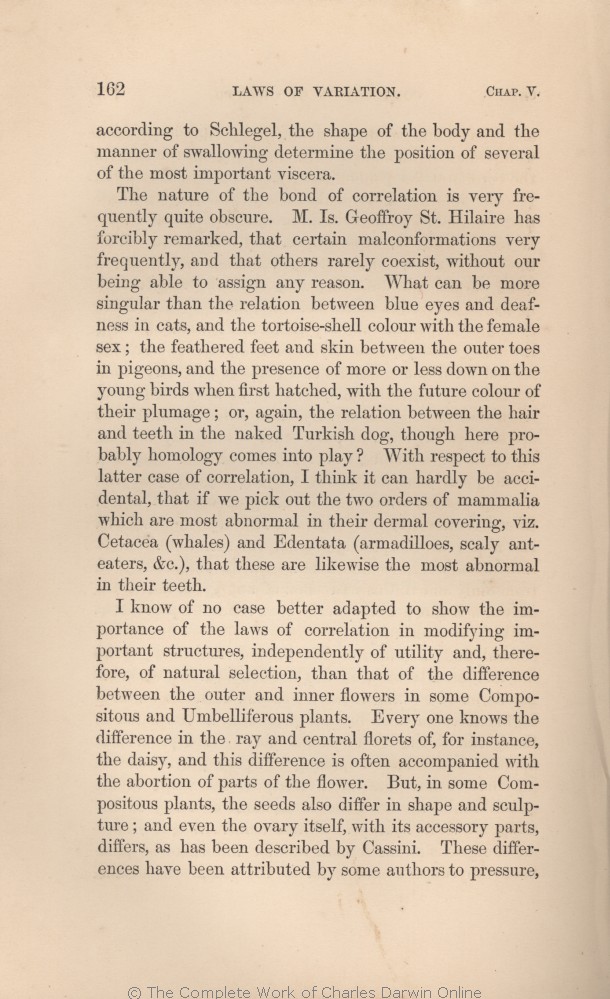according to Schlegel, the
shape | shape 1859 1860 1861 1866 1869 | | form 1872 |
| of 1859 1860 1861 1866 |
| and form of 1869 1872 |
|
|
The nature of the bond
of correlation is very | of correlation is very 1859 1860 1861 1866 |
| of correlation is 1869 |
| is 1872 |
| very 1859 1860 1861 1866 1869 | very 1872 |
| rarely 1859 1860 1861 1866 1869 | | rarely, 1872 |
| coexist, 1859 1860 1861 1866 1869 | | co-exist, 1872 |
| the 1859 1860 1861 1872 |
| in cats the 1866 1869 |
| between blue eyes and deafness 1859 1860 1861 |
| between complete whiteness with blue eyes and deafness, 1866 1869 |
| OMIT 1872 |
| in cats, and 1859 1860 1861 |
| or between 1866 1869 |
| in cats between complete whiteness and blue eyes with deafness, or between 1872 |
| with 1859 1860 1861 | | and 1866 1869 1872 |
| the 1859 1860 1861 |
| or in pigeons between their 1866 1869 1872 |
| between 1859 1860 1861 | | betwixt 1866 1869 1872 |
| toes 1859 1860 1861 | | toes, 1866 1869 1872 |
| in pigeons, and 1859 1860 1861 |
| and between 1866 |
| or between 1869 1872 |
| birds 1859 1860 1861 | | bird 1866 1869 | | pigeon 1872 |
| their 1859 1860 1861 | | its 1866 1869 1872 |
| probably 1859 1860 1861 | | no doubt 1866 1869 1872 |
| that 1859 1860 1861 1872 | | that, 1866 1869 |
| if we pick out 1859 1860 1861 1866 1869 |
| OMIT 1872 |
| mammalia 1859 1860 1861 | | mammals 1866 1869 1872 |
| covering, 1859 1860 1861 1866 1869 | | coverings, 1872 |
| viz. 1859 1860 1861 1866 | | viz., 1869 1872 |
| ant-eaters, 1859 1861 1866 1869 1872 | | anteaters, 1860 |
| that these 1859 1860 1861 | | these 1866 1869 | that these 1872 |
| the 1859 1860 1861 1866 1869 |
| on the whole the 1872 |
| teeth. 1859 1860 1861 1866 1869 |
| teeth; but there are so many exceptions to this rule, as Mr. Mivart has remarked, that it has little value. 1872 |
|
|
I know of no case better adapted to show the importance of the laws of
correlation in modifying important structures, | correlation in modifying important structures, 1859 1860 1861 |
| correlation in leading to modifications of important structures, 1866 |
| variation and correlation, 1869 |
| correlation and variation, 1872 |
| and, 1859 1860 1861 | | and 1866 1869 1872 |
| therefore, 1859 1860 1861 | | therefore 1866 1869 1872 |
| of 1859 1860 1861 1866 1872 |
| before referred to, of 1869 |
| knows 1859 1860 1861 1866 1869 |
| is familiar with 1872 |
| in 1859 1860 1861 1866 1869 | | between 1872 |
| abortion of parts 1859 1860 1861 1866 |
| partial or complete abortion 1869 1872 |
| flower. 1859 1860 1861 1866 | | reproductive organs. 1869 1872 |
| But, 1859 1860 1861 1866 | | But 1869 1872 |
| Compositous 1859 1860 1861 1866 | | of these 1869 1872 |
| sculpture; 1859 1860 1861 1866 | | sculpture. 1869 1872 |
| and 1859 1860 1861 1866 | and 1869 1872 |
| even 1859 1860 1861 1866 | even 1869 1872 |
| the 1859 1860 1861 1866 | the 1869 1872 |
| ovary 1859 1860 1861 1866 | ovary 1869 1872 |
| itself, 1859 1860 1861 1866 | itself, 1869 1872 |
| with 1859 1860 1861 1866 | with 1869 1872 |
| its 1859 1860 1861 1866 | its 1869 1872 |
| accessory 1859 1860 1861 1866 | accessory 1869 1872 |
| parts, 1859 1860 1861 1866 | parts, 1869 1872 |
| differs, 1859 1860 1861 1866 | differs, 1869 1872 |
| as 1859 1860 1861 1866 | as 1869 1872 |
| has 1859 1860 1861 1866 | has 1869 1872 |
| been 1859 1860 1861 1866 | been 1869 1872 |
| described 1859 1860 1861 1866 | described 1869 1872 |
| by 1859 1860 1861 1866 | by 1869 1872 |
| Cassini. 1859 1860 1861 1866 | Cassini. 1869 1872 |
| been attributed by some authors to pressure, and the shape 1859 1860 1861 1866 |
| been attributed by some authors to the pressure 1869 |
| sometimes been attributed to the pressure 1872 |
|









